A tradition for more than two decades, the Oregon Star Party Telescope Walkabout celebrates and promotes telescope making. As a group we walk from telescope to telescope, meeting each builder, listening to their story. What is the telescope all about? What works? What doesn't? What would they change next time? Sometimes it is a novel idea, sometimes it is a beginner's first effort. We ask questions as a group, benefiting collectively. The popularity of the walkabout over the years shows its value to amateurs. Ask yourself if you'd rather be answering judges' questions or talking about your telescope to an appreciative crowd.
The Oregon Star Party has seen the invention and early adoption of automation, flex rockers, string telescopes, Tensegrity tube structures, wire spiders, computerized drive systems, direct drive motors, TrackBalls, SudiBalls, ultra-lights, three large one meter reflectors, super fast sub-F3 reflectors, folding light path reflectors, travel and folding scopes, 3-axis mounts, novel observing accessories, meniscus mirrors, ultra-thin mirrors, Lurie-Houghtons and Schiefspieglers, a number of binoscopes, club scopes and tracking platforms. Especially we take time to celebrate 'first' telescopes made by kids and adults. Invariably there is a fresh take, a new approach or a novel idea.
Mel Bartels waiting for the crowd to assemble. Telescope inventor Pierre Lemay with his wife France from Montreal.
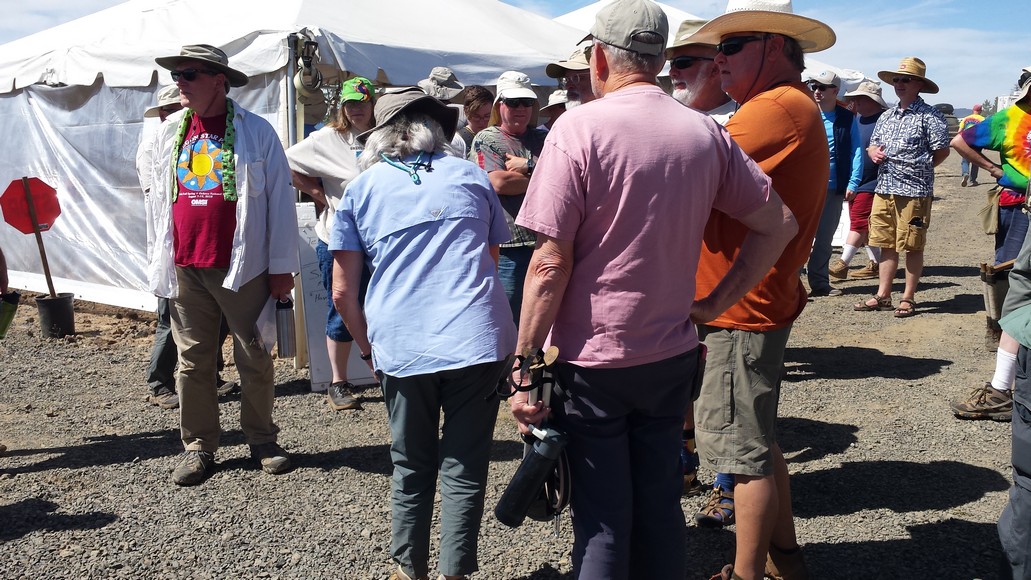
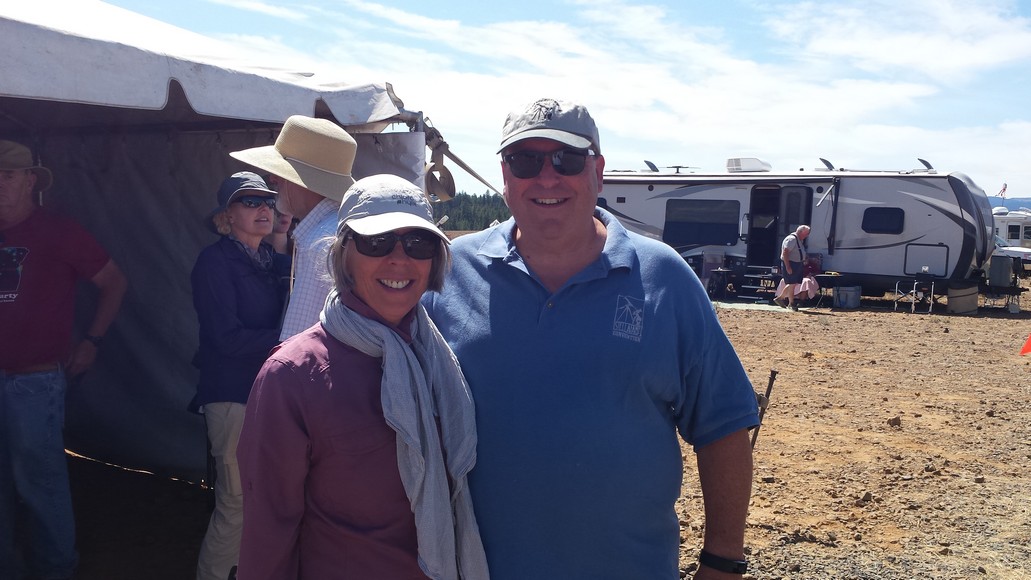
Ed's 'Elvira' is a marvel of automation. I've never seen a telescope like this. Ed explained that he engineered four major systems.
The first is the crawler that moves the scope about. The crawler holds batteries and is a Swiss army knife. The scope powerlifts out on legs that elevate and then auto-level. The auto-level is left turned on throughout the night. There are shelves for eyepieces. All parts disassemble and stack together. In the image below you can see the Walkabout crowd following the crawler as it moves across the observing field.
The second system is the electronic clutch. It is designed to re-center the object after the scope is bumped at high powers. The clutch system does not require balancing. The upper cage can be attached with the tube at an angle as opposed to vertically if desired because of clutch locking. All the standard goto options are available.
The third engineered system is the ventilation system. A high capacity squirrel fan and HEPA filter pushes air around back of mirror then over edge then onto the face of the mirror then to top of tube which warms the diagonal. A shroud is required. The mirror is cooled in the evening before observing with a vented mirror cover. The cooling is radial and symmetrical which is faster. An added bonus is that the mirror stays particularly clean.
The final system is the electric collimation with laser and TuPlug Glatter alignment tool. The conception for the system was 'laziness'.
Ed employs a Dan Gray SiTech drive and uses the scope up to 900x though the scope is capable of more magnification when seeing allows.
It was difficult getting good pictures of the telescope with such a large crowd. For more on this unique telescope, see Pierre's video where the crowd walks along with the crawler and the Cloudy Nights discussions.
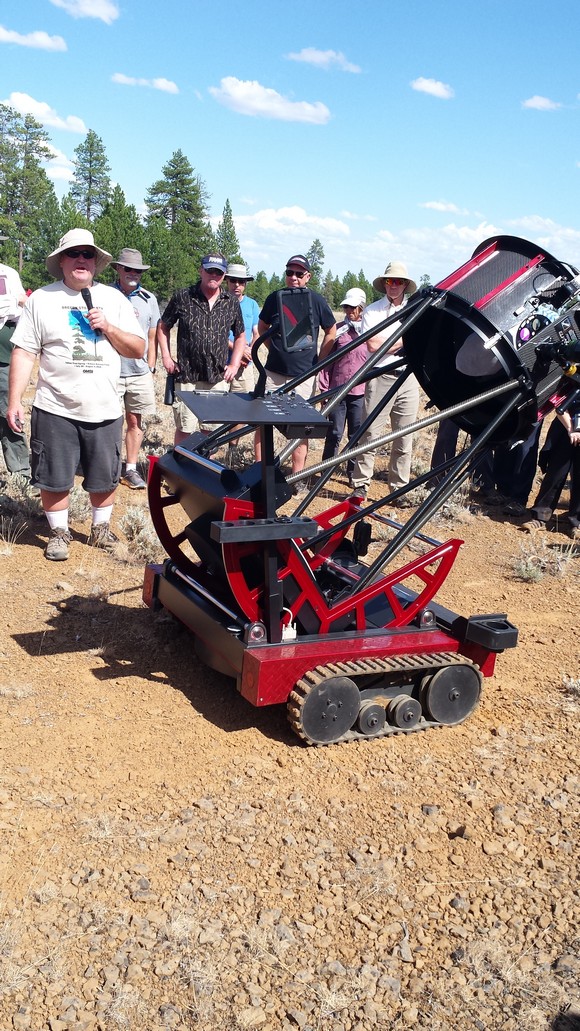
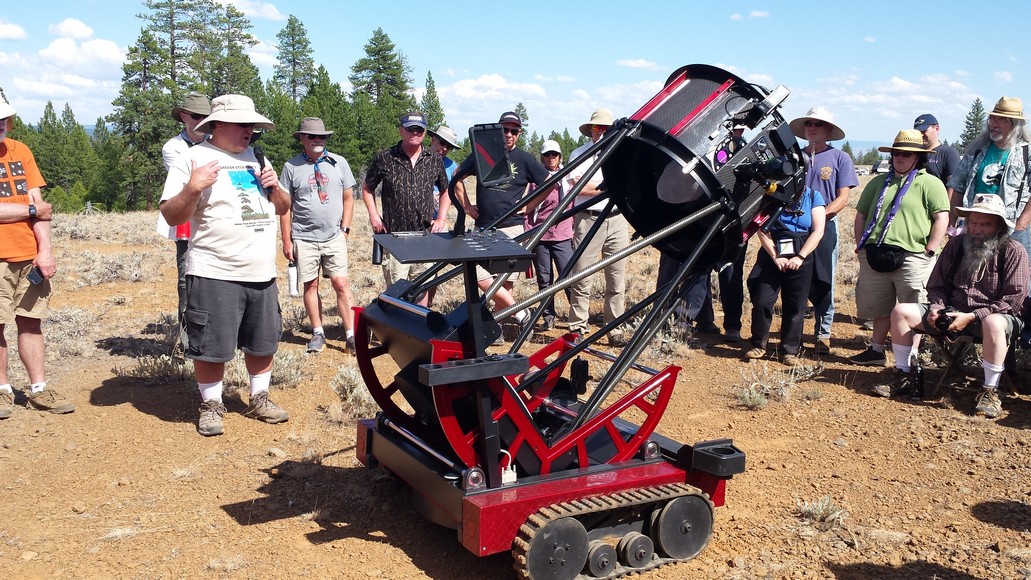
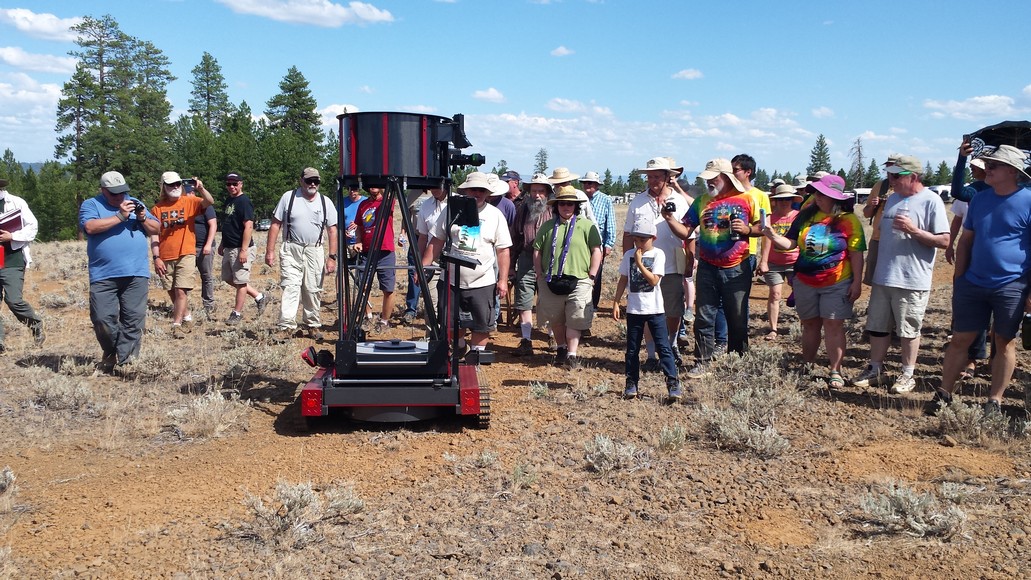
Robert brought his new version II binoculars, a significant change from last year.
His scope features magnetic eyepiece and filter holders which allow quick eyepiece change-out in seconds. This is doubly important in a binoscope! The eyepieces parfocalized with a collar. Parts are 3D printed including tripod using green-tech-pro printing material. The secondary mirror hub is printed aligned with no adjustment possible. The primary mirror cells from Aurora Precision which do not move. The OTA collapses for travel with a sliding mechanism. And the tripod moves up and down for eyepiece height. The design includes joystick magnetic handles to move scope.
IPD is an easy adjustment with an interlocking gear that slides back and forth with an adjustment range of 58-75mm.
His development process is innovative: 3D print a simple interface to the rest of the scope, then rapidly iterate by designing and refining the part in question. In effect, his computer workstation becomes his workshop. He likes fusion360 for software. Robert estimates a couple of thousands of hours of design. M24 is Robert's favorite object along with Oltion's Caribou and M8, also clouds when the cross the moon. The most astounding view that I had was the moon just after sunset. The contrast, the detail and the 3D effect made for an image I will never forget.


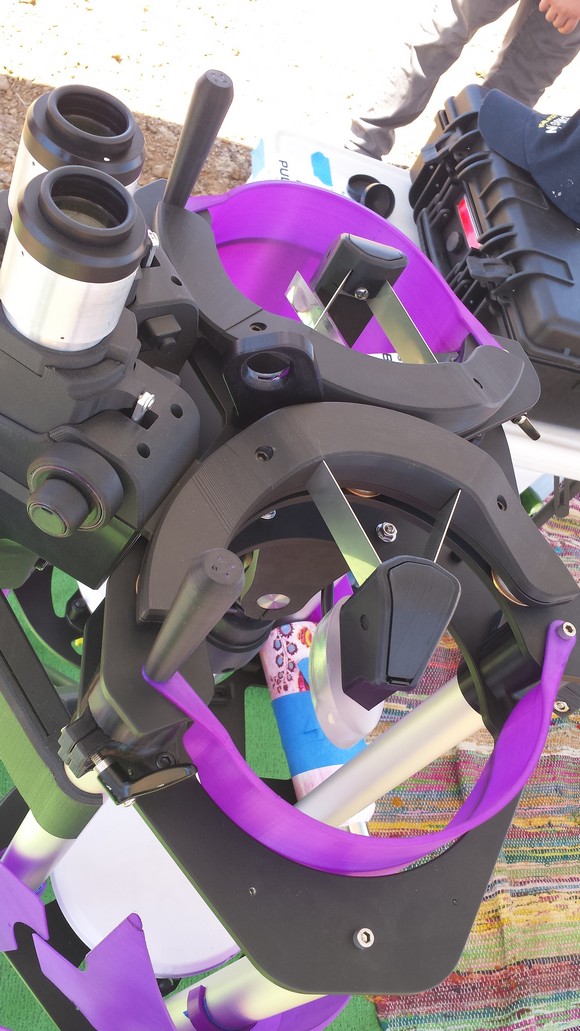

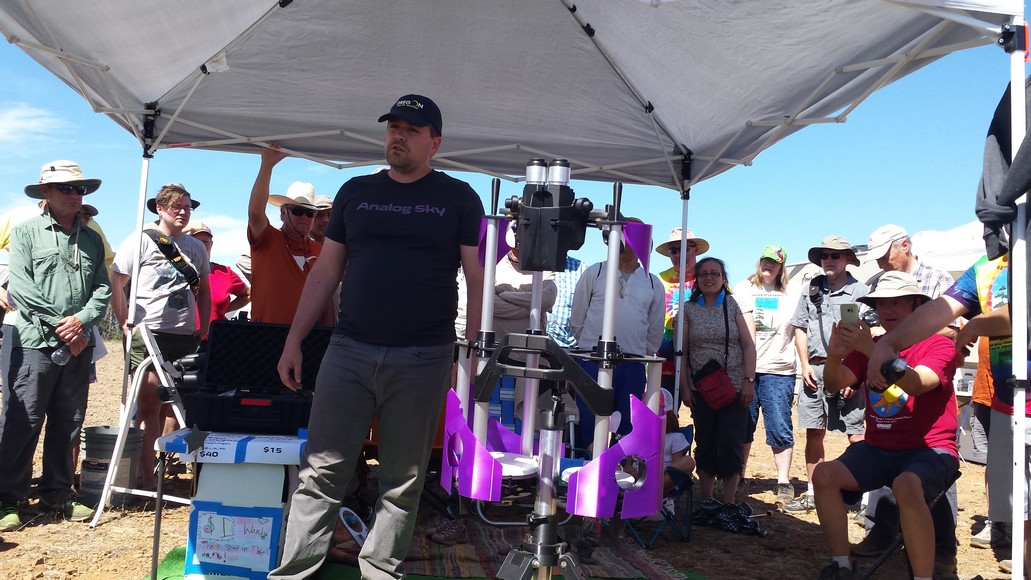
For more, visit Robert's webpages.
Being shown at OSP concurrent with Stellafane, a subset of the Oregon Scope Werks has been working on bringing long lasting high reflectivity silver coatings to amateurs. Howard's 28 inch is an example of the group's latest efforts.
Howard uses leaf blower to clean dust after observing - the dust flies off the silver. He says that he expects to get maybe 10 coatings per kit which costs $360. The silver coating perfectly preserves the glass figure. The spray application works because silver only sticks to the glass, not itself, so the thickness is self-regulating. The residue is collected and solidified for environmentally safe disposal. Silvering is good for smaller mirrors too.
Howard built a wooden jig that tilts the mirror easily. He says that a motivated 14 year old can do this if they can follow directions. While there is a learning curve in that the first coating may not turn out, it is a simple process but 95% of process is cleaning the mirror in preparation for the coating. Other amateurs besides Howard are now successfully applying silver coatings. The silver is applied in his garage. I can attest that the views are simply tremendous with a measured 97% reflectivity. The OSW group has also developed a reflectivity test that uses a digital camera. In essence, this is the same old silver coating as used going back decades. The process is not silver spray painting. A key innovation is the incorporation of a protected overcoat developed using an anti-tarnish agent which is easy to apply and will give an estimated 5-10 year life.
Jerry Oltion, editor at Sky and Telescope magazine, is writing on article on silvering for an upcoming issue. For details on the silvering process being developed by the Oregon Scope Works, go here


Four years ago Frank, one of the top binoscope builders in the world, built 'Popeye'. He decided to downgrade but keep the base and rocker. He found two 10" mirrors in Eugene and put them to use. He vents with a fan. The design is two Newtonian tubes with side viewing.
There are a number of adjustments on the binocular telescope which uses a reversed Crawford design that holds 2 inch eyepieces, a rarity in binoscope design. InterPupilary Distance (the spacing between the eyes) adjustment is accomplished by moving one primary with an adjustment arm. Frank followed William Herschel's design from 200 years ago who attempted to build such a telescope. One key advantage is that four instead of six mirrors are used. One diagonal is larger than the other and one primary is closer than the other.
Frank points out that his 10 inch binoscope is equivalent to a 14" F3 without having to make crazy fast optics.

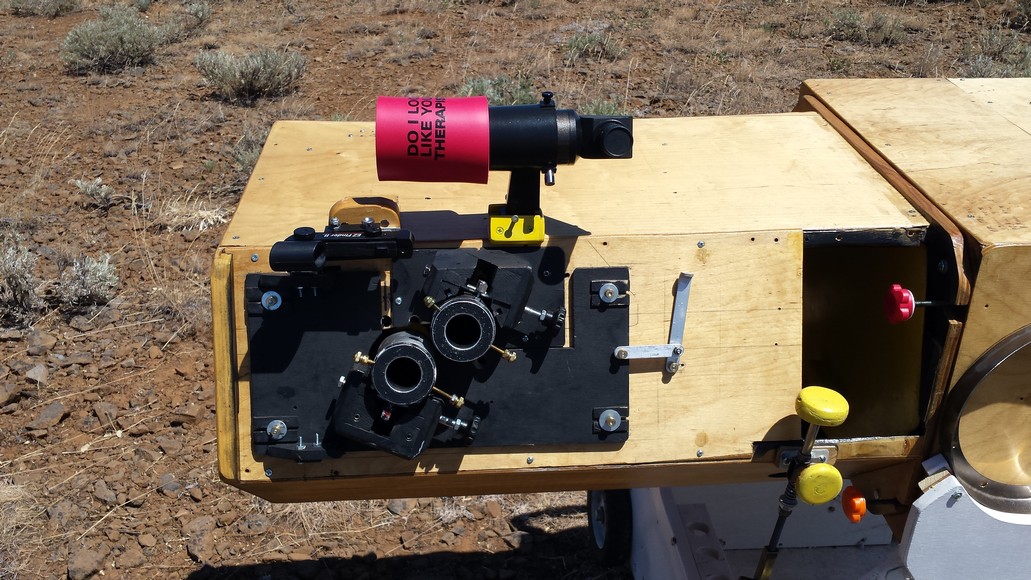
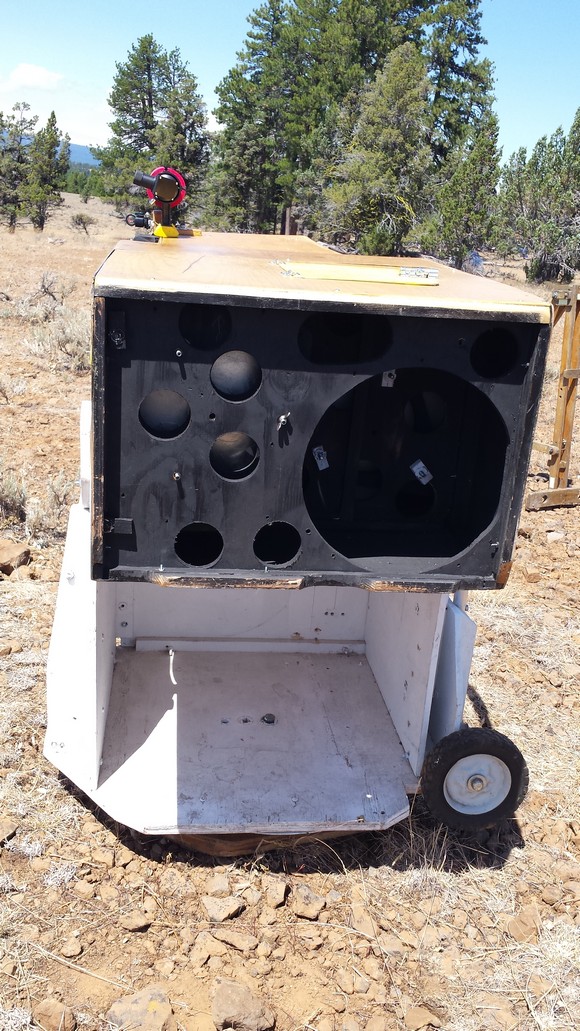
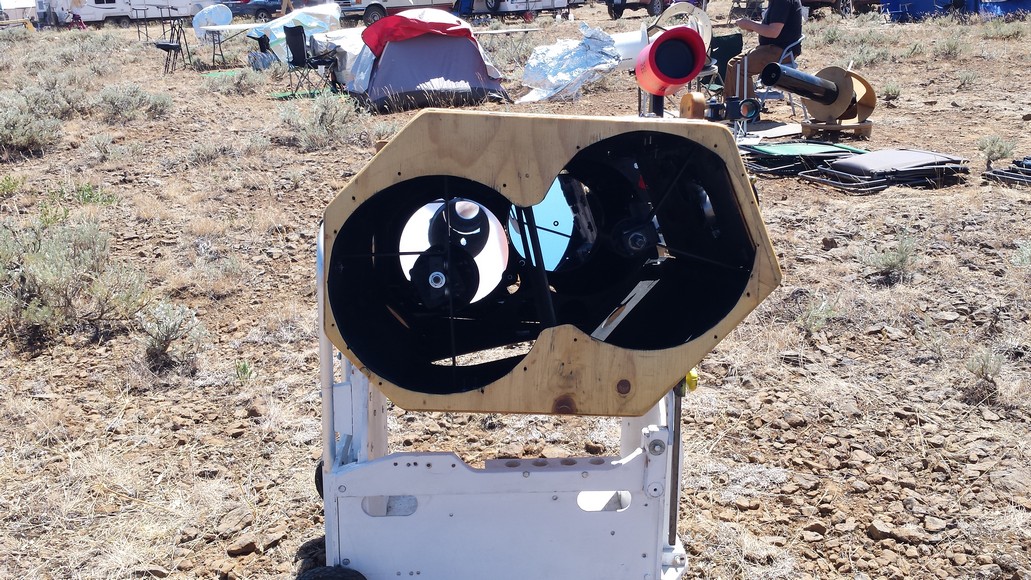
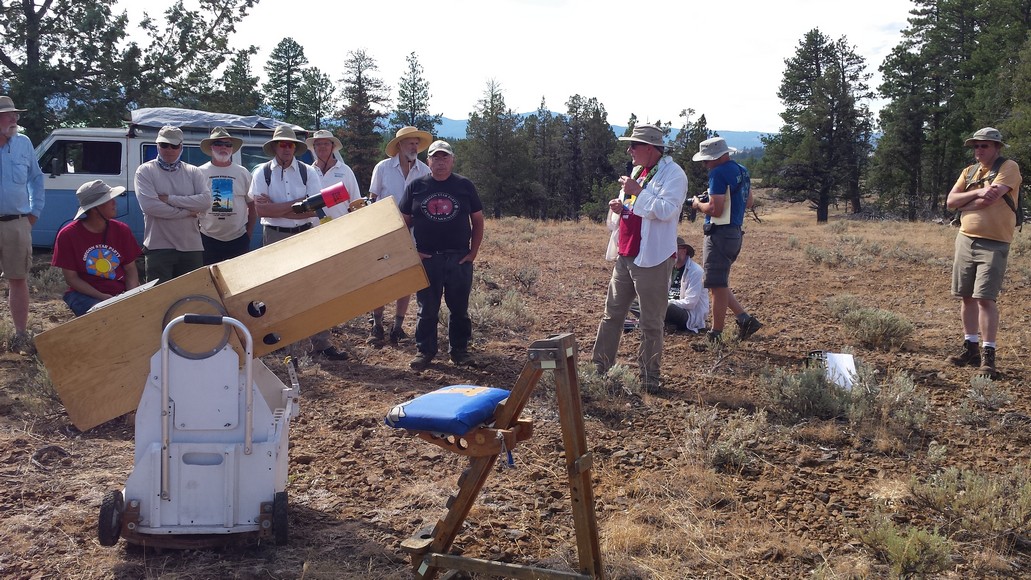
Greg brought the perfect pair of homebuilt telescopes: a wide field 5.25 inch RFT and a high power 12.5 inch Springfield. Both are wonderful examples of inventive thinking, design and building. Greg likes to build scopes on a tight budget and from junk and re-purposed parts.
The smaller scope uses a Beseler 5.25 inch diameter F4 lens from an opaque projector. This is a grab and go scope. The mount features an unusual variable height pier. It is a favorite scope of Greg's. He added altaz setting circles; there are no electronics.
The larger scope is a 2-3 hour setup and follows the Springfield mounting invented by Russell Porter, an innovator. The key feature is a fixed eyepiece. Greg made some modifications from the original Springfield design, for example, he uses two counterweights instead of one. The scope has a three leg hoist and an intriguing sliding focuser with nearby tangent arm slo-motions controls. He uses a cordless screwdriver to clamp the RA drive which uses a traveling threaded rod to drive a cable wrapped around a disc. The drive is powered with a falling weight and is biased eastward against the drive action.
Greg built setting circles using measuring tape: he cut them slightly undersized then added paint until tape fit perfectly. The secondaries are high quality 1/20 wave since the Springfield design uses two diagonals. He uses a HEPA ventilated filter from Home Depot with fan. The scope is designed to ride high up in the air for cleaner optics and to avoid bad seeing in the ground effect air. About one battery charge is good for a cooldown, as the battery fades so does the fan, matching the thermal requirement for cooling. The fan also eliminates tube currents which sharpens the image. He uses single curved vane spiders and prefers closed tubes for dust and bug control. Finally, Greg built an observing platform with booster step.
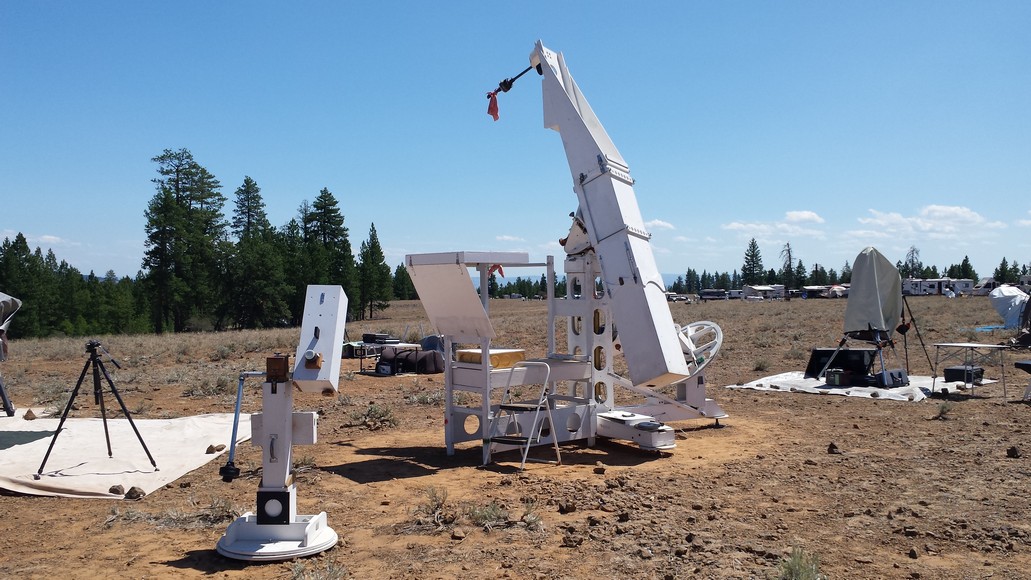
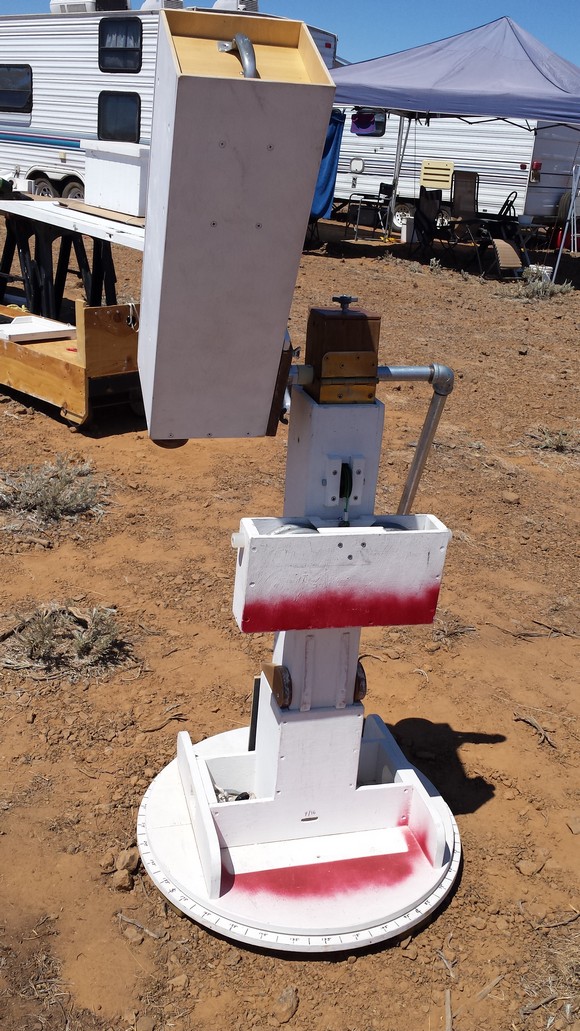
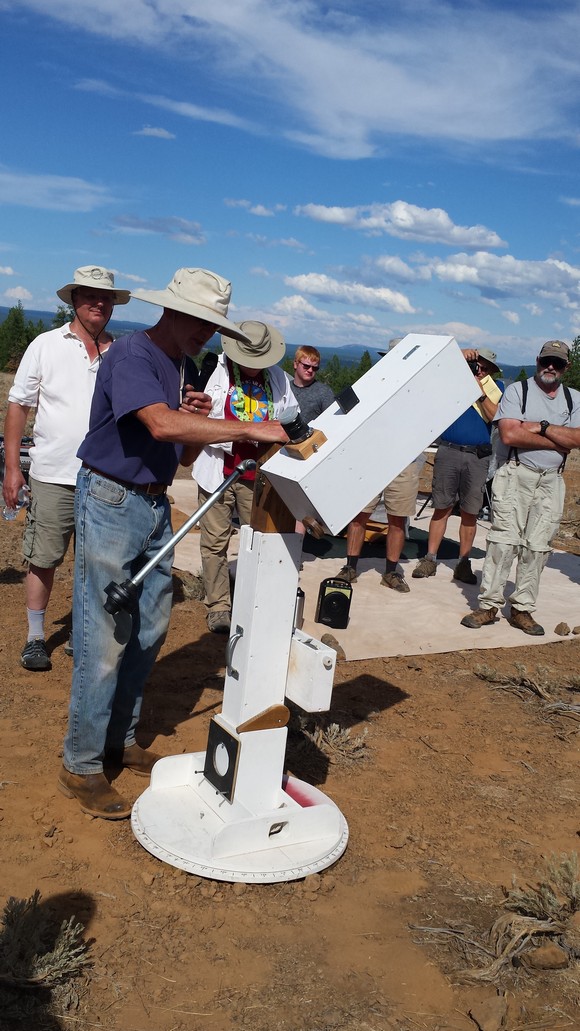
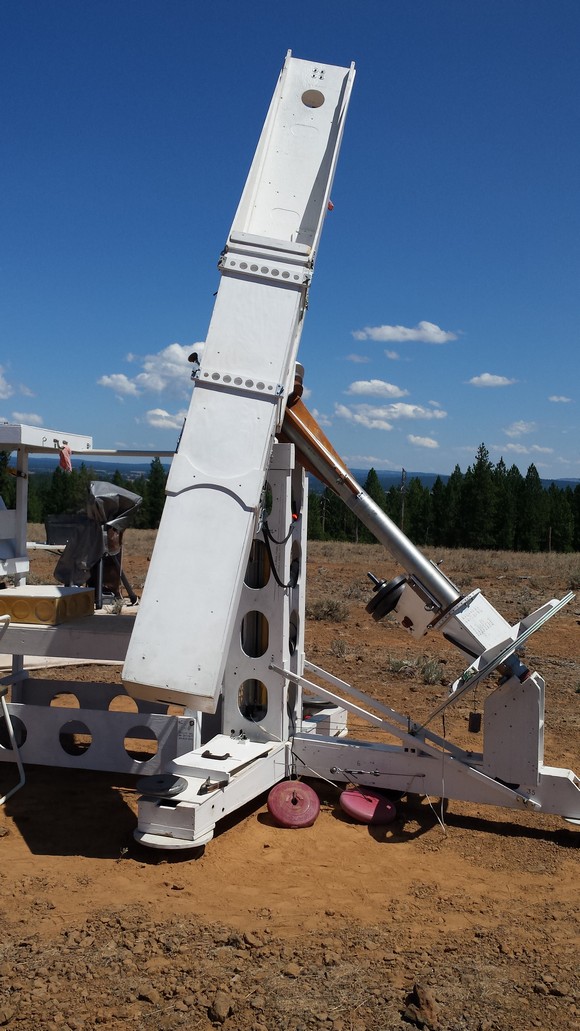
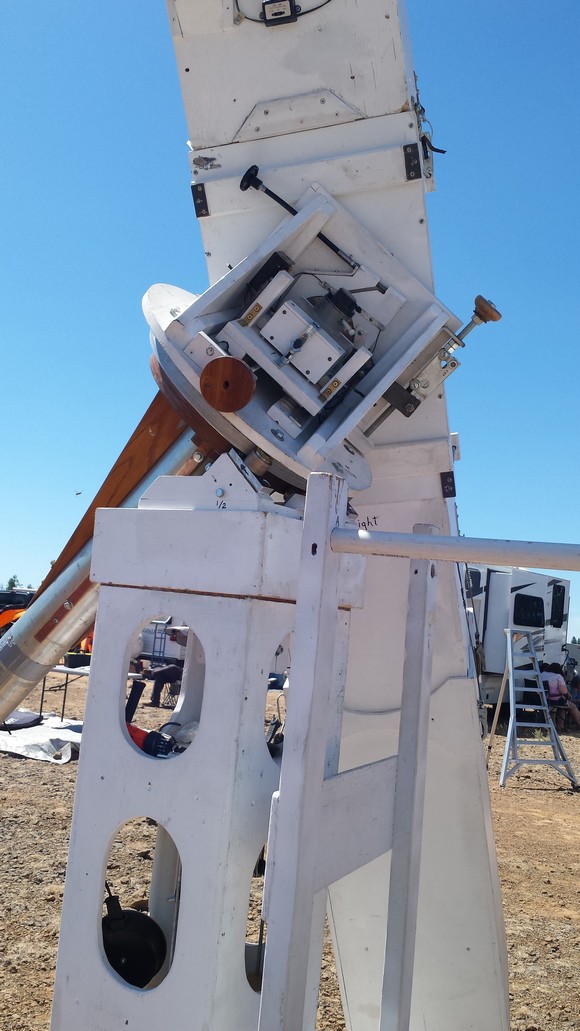
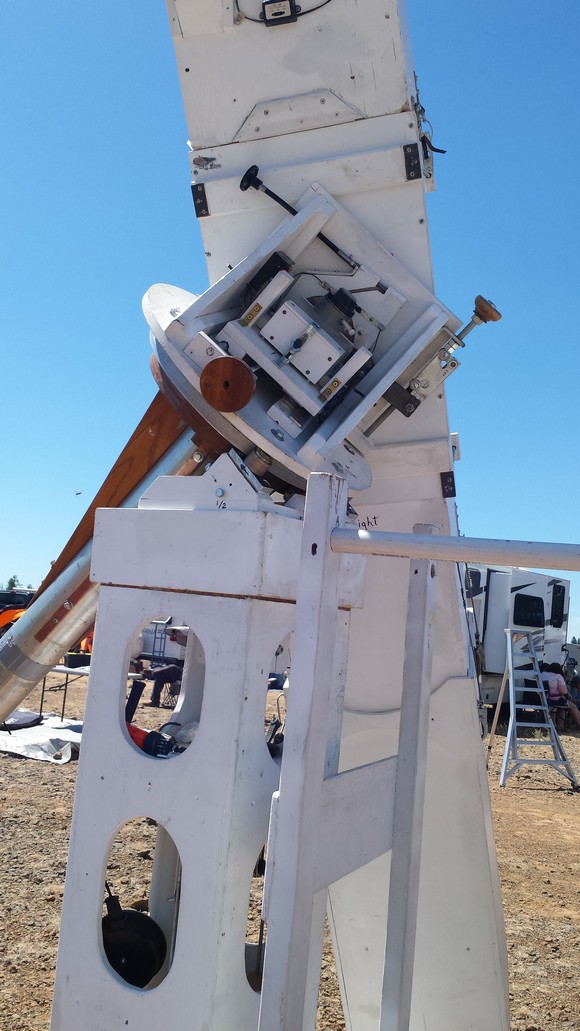
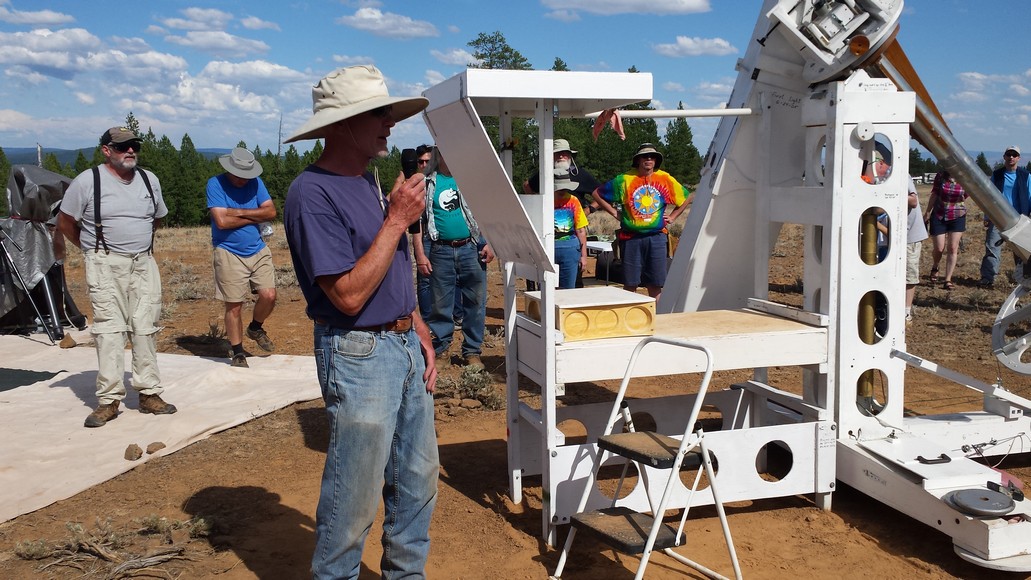

eod